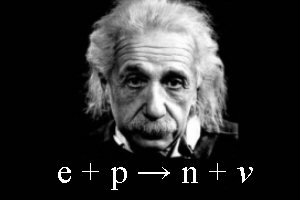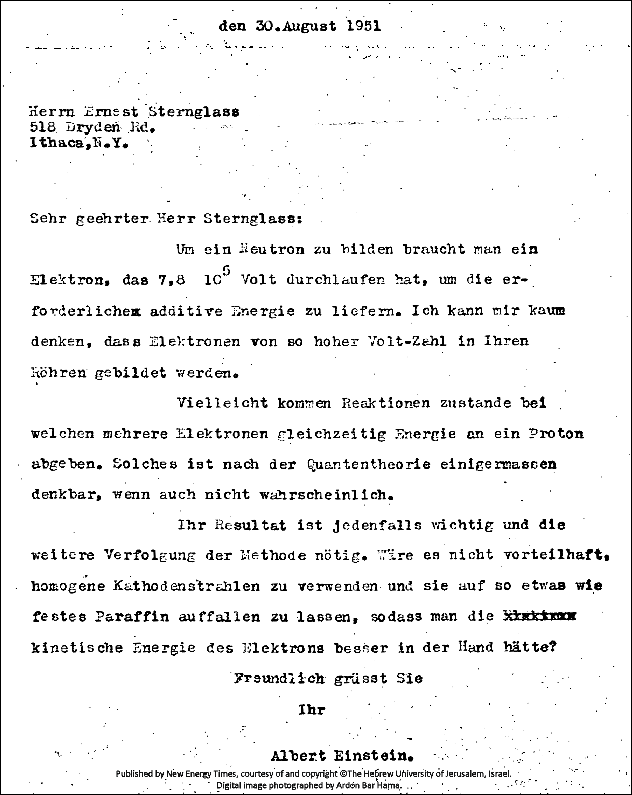
Uncovering History
One Saturday night in 2006, theorist Lewis Larsen was browsing at a Border's bookstore in Chicago. In the $2.99 discount section of the store, he saw a 1997 book by physicist Ernest Sternglass: Before the Big Bang: The Origins of the Universe.
"I had heard a little bit about Sternglass so I decided to pick it up and read it and then found this amazing story," Larsen said. "The day after, I called Allan and Yogi and said 'You're not going to believe what I just found.'"
Larsen, working with Allan Widom, had developed a theory to explain low-energy nuclear reaction (LENR) experimental results. The pair later collaborated with Yogendra Srivastava.
Larsen seems to have been the first person to recognize the significance of the 1950s neutron story. Larsen was so intrigued that he called Sternglass, who was 83 at the time, and, over several hour-long phone calls, interviewed Sternglass (1923-2015). Five years later, on Nov. 25, 2011, Larsen wrote a two-page article about his findings and published it on the Slideshare Web site.
I wrote my first article about this on Dec. 23, 2012. My editors and I were so intrigued that we later organized an effort to locate archival records: Sternglass’ papers, held by Cornell University Libraries, and Einstein’s letter correspondence with Sternglass, held by Hebrew University of Jerusalem.
A Daring Idea
In 1947, 24-year-old Sternglass had recently completed his undergraduate degree in electrical engineering at Cornell University. He was working at the Naval Ordnance Laboratory in Maryland.
Sternglass had extensively studied the scientific literature of experiments performed in the 1920s in which James Chadwick had passed thousands of volts of electricity through hydrogen-filled tubes in his search for evidence of neutral particles.
In the 1910s and 1920s, scientists experimented with such tubes and found evidence of atomic transmutations produced in experiments with low-energy inputs. The experimental data made no sense to any of these scientists, and by the 1930s, the research was largely abandoned and assumed to be the result of mistakes or errors. My book, Lost History: Explorations in Nuclear Research, Vol. 3, reviews this forgotten work in detail.
Sternglass does not seem to have known about the low-energy transmutation experiments from the 1910s and 1920s, but he was aware of earlier theoretical work published by English physicist Charles Galton Darwin (1887-1962). Sternglass wrote in his book that he had learned about Darwin's 1913 ideas about electron capture by a proton. In a 1920 paper, "On the Dynamical Motions of Charged Particles," Darwin also described collective many-body excitations of electrons. C.G. Darwin was a noted physicist and the grandson of Charles Darwin the famous evolutionary biologist. According to the implications of C.G. Darwin's calculations, as Sternglass wrote in 1997, neutrons might be formed by capturing an electron, even at low energies.
Collective effects take place when many individual units contribute something — like energy — to a single unit. It does not seem that Sternglass knew about the collective effects Darwin had described in 1920 prior to his conversations with Einstein. Einstein, a contemporary of C.G. Darwin, likely knew of Darwin's collective effect ideas.
In Sternglass' book, he wrote that he had "speculated that on rare occasions an electron coming sufficiently close to a proton might be captured to form a neutron." Sternglass also recognized that a relatively simple way to produce neutrons could lead to profound changes in science, technology, and weapons.
He was proposing a process with free electrons, outside of an atomic nucleus, not electron capture, which takes place inside a nucleus. He thought that, through a proton capturing a free electron, neutrons could be formed at low energies. Because of the required energy input, this was considered impossible at the time. That didn't deter him.
An Inexplicable Result
Sternglass went back to Cornell and, while looking around in the basement of a physics laboratory, found an old X-ray tube similar to the one Chadwick had used. Sternglass knew that the reaction would require a minimum input of 780 KeV and that the tube could provide, at most, 35 KeV. But he performed the experiment and, in fact, saw evidence of neutron production.
"Experiments that I began in 1951 in pursuit of an electromagnetic model for the neutron showed that neutrons could apparently be formed from protons and electrons at very low energies, far below the energy predicted by the existing theory," Sternglass wrote.
No one in the Physics Department at Cornell, including Hans Bethe, who later won the 1967 Nobel Prize in Physics for his work on the theory of stellar nucleosynthesis, was able to suggest a possible explanation for his results. On August 26, 1951, Sternglass wrote to Einstein.
"You may be interested to learn that in the course of the past two months I have been able to obtain experimental evidence for the formation of neutrons from protons and electrons in a high-voltage hydrogen discharge," Sternglass wrote.
Einstein wrote back four days later:
In order to form a neutron, an electron is needed that has passed through 7.8 x 105 volts in order to provide the required additional energy. I can hardly imagine that electrons of such high voltage are formed in your tubes. Perhaps reactions occur in which multiple electrons simultaneously transfer energy to one proton. According to quantum theory, this is somewhat conceivable, although not probable.
Chapter 27 of my book Hacking the Atom discusses the Sternglass experiment and history in greater detail.

Published by New Energy Times, courtesy of and copyright ©The Hebrew University of Jerusalem, Israel.
Digital image photographed by Ardon Bar Hama.
Collective Effects and Surface Plasmons
In the late 1990s, Larsen, without knowing anything about the Sternglass work or his correspondence with Einstein, had independently envisioned how ultra-low momentum neutrons could be formed in low-energy nuclear reaction experiments.
Larsen had determined that collective effects among electrons — essentially what Einstein described — were intrinsic to his initial development of the Widom-Larsen theory. Larsen explained to me the key differences that enabled him to go further than Einstein and Sternglass. First, Larsen explained that surface plasmons — coherent delocalized electron oscillations — that can exist on metal surfaces, were only predicted to exist in 1957, and experimentally confirmed in later years.
"If Sternglass had known about surface plasmons, he and the crew of crack physicists at Cornell (Bethe, Feynman, Morrison, etc.,) along with Einstein's help, probably would have soon cracked it conceptually and beaten Widom and Larsen to the punch by 50 years," Larsen said.
Subsequent developments in physics helped Larsen to formulate his concept for the theory:
By 1970, nuclear physicists were convinced that nucleosynthesis was only possible in stars or by fission reactors, or nuclear weapons. They thought that transmutations by any other means was inconceivable. The [transmutation] work in the 1910s and 1920s, despite being front-page news at the time, had now been completely forgotten. By the mid-1970s, Lev Landau and Evgeny Lifshitz published a theoretical calculation in which they showed that effective electron mass could be increased substantially by bathing electrons in nuclear-strength electric fields. They did not see how that might be useful. Also by this time, it had become apparent to physicists and chemists who were researching surface processes that that the Born-Oppenheimer approximation breaks down completely on surfaces and at interfaces. The approximation was a tool that had been used since 1927 to simplify quantum mechanics calculations that would otherwise be computationally impossible.
Larsen helped me to understand the main concepts of his and Widom's theory and I explain it, for lay readers, in chapters 25-27 in Hacking the Atom.
Note: Special thanks to Michael Ravnitzky, who obtained copies of Einstein's letters to Sternglass from the Albert Einstein Archives at Hebrew University of Jerusalem, and to Shamil Shirish Khedgikar, whom Ravnitzky commissioned to review and obtain copies of Sternglass' laboratory notebooks and other papers at the Cornell University Archives.
|

